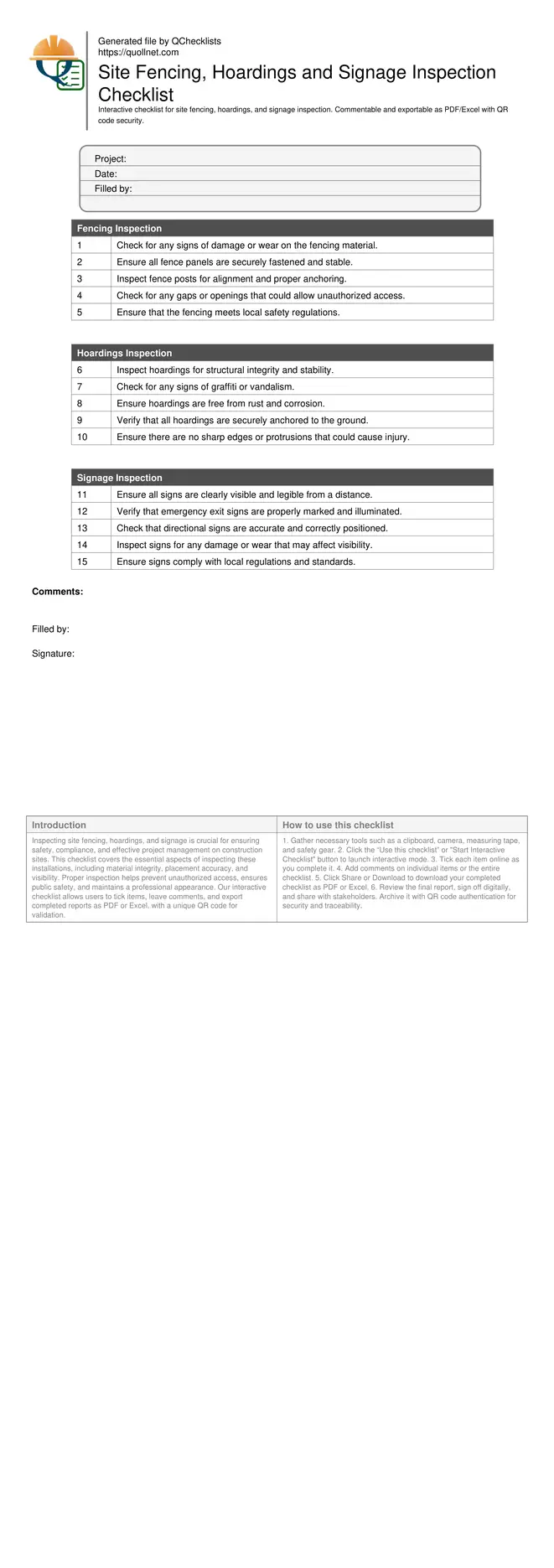Site Fencing, Hoardings and Signage Inspection
Inspecting site fencing, hoardings, and signage is crucial for ensuring safety, compliance, and effective project management on construction sites. This checklist covers the essential aspects of inspecting these installations, including material integrity, placement accuracy, and visibility. Proper inspection helps prevent unauthorized access, ensures public safety, and maintains a professional appearance. Our interactive checklist allows users to tick items, leave comments, and export completed reports as PDF or Excel, with a unique QR code for validation.
- Ensure site safety and compliance by inspecting fencing and hoardings for structural integrity.
- Verify signage visibility and accuracy to maintain clear communication and site organization.
- Interactive online checklist with tick, comment, and export features secured by QR code.
- Prevent unauthorized site access and enhance public safety with thorough inspections.
Fencing Inspection
Hoardings Inspection
Signage Inspection
Importance of Fencing and Hoardings
Site fencing and hoardings are the first line of defense against unauthorized access and serve as a barrier for both safety and privacy. Inspections should focus on ensuring these barriers are stable, durable, and free from defects. Routine checks help identify any potential risks that could lead to accidents or security breaches.
- Check for any signs of rust or corrosion on metal parts.
- Ensure all panels and posts are securely anchored.
- Inspect for any gaps or weaknesses in the structure.
Signage Installation and Inspection
Signage on a construction site is critical for communication and safety. Properly installed and maintained signs guide workers and visitors, reducing the risk of accidents. Inspections should verify that all signs are clearly visible, accurate, and in good condition, with appropriate lighting for night visibility if needed.
- Ensure signs are placed at eye level for maximum visibility.
- Check that all emergency exit signs are clearly marked.
- Verify that directional signs are correctly positioned.
Ensuring Compliance and Safety
Compliance with local regulations is mandatory for construction sites. Regular inspections of fencing, hoardings, and signage can prevent costly fines and ensure the safety of workers and the public. This checklist is designed to help maintain these standards through thorough and systematic inspections.
- Review local regulations for specific signage requirements.
- Ensure all safety signs meet industry standards.
- Document any non-compliance issues and address them promptly.
How to Use the Site Fencing, Hoardings, and Signage Inspection Checklist
- Gather necessary tools such as a clipboard, camera, measuring tape, and safety gear.
- Click the “Use this checklist” or "Start Interactive Checklist" button to launch interactive mode.
- Tick each item online as you complete it.
- Add comments on individual items or the entire checklist.
- Click Share or Download to download your completed checklist as PDF or Excel.
- Review the final report, sign off digitally, and share with stakeholders. Archive it with QR code authentication for security and traceability.
Call to Action
- Start Checklist Tick off tasks, leave comments on items or the whole form, and export your completed report to PDF or Excel—with a built-in QR code for authenticity.
- Download Excel - Site Fencing, Hoardings and Signage Inspection
- Download PDF - Site Fencing, Hoardings and Signage Inspection
- View Image - Site Fencing, Hoardings and Signage Inspection

